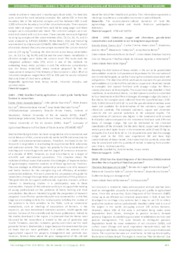Can the Quick Diagnosis of Soil Structure (DRES) method describes the soil quality of Brazilian pastures?
Can the Quick Diagnosis of Soil Structure (DRES) method describes the soil quality of Brazilian pastures?
Author(s): VALLE, T. R. de S.; RODRIGUES, R. de A. R.; BALIEIRO, F. de C.; FONTANA, A.; SANTOS, M. L.; DONAGEMMA, G. K.
Summary: Soil structure is related to many soil ecosystem services and has been used as manageable property in evaluating soil quality in agricultural areas. From this perspective, Quick Diagnosis of Soil Structure (DRES) shows up as an efficient soil structure assessment in field. It was first developed to no-tillage crop systems but it may be well fit to others productive systems such as pasturelands. Brazilian cattle herd is one of the largest in the world, occupying around 159 million hectares. However, about 50% of this area is estimated being under some degradation level. Hence, strategies to pasture recovery demand previous diagnosis to stablish appropriated rehabilitation technics and pasture management. This work intends to distinguish pastures degradation levels by visual evaluation of soil structure (DRES), soil surface cover (forage and weed vegetation characteristics) and the following soil attributes: mean weight diameter, soil C concentration and stocks.
Publication year: 2019
Types of publication: Abstract in annals or event proceedings
Unit: Embrapa Soils
Keywords: Degradation, Degradação Ambiental, Estrutura do Solo, Pastagem, Pastures, Soil structure
Observation
Some of Embrapa's publications are published as ePub files. To read them, use or download one of the following free software options to your computer or mobile device. Android: Google Play Books; IOS: iBooks; Windows and Linux: Calibre.
Access other publications
Access the Agricultural Research Database (BDPA) to consult Embrapa's full library collection and records.
Visit Embrapa Bookstore to purchase books and other publications sold by Embrapa.

